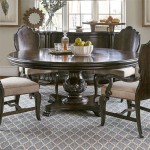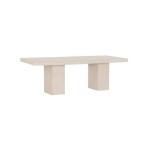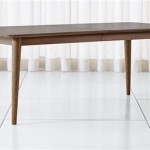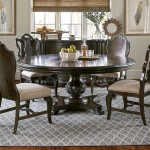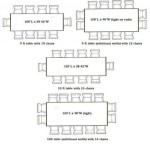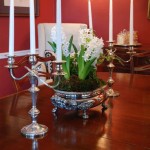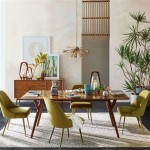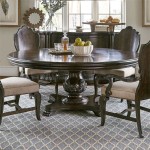The Enduring Appeal of the Large Round Wooden Dining Table
The large round wooden dining table stands as a classic and versatile furniture piece, finding its place within a diverse array of interior design styles and serving as a focal point for gatherings large and small. Its inherent warmth, visual appeal, and functional design contribute to its enduring popularity. This article will explore the key characteristics, practical benefits, aesthetic considerations, and maintenance requirements associated with large round wooden dining tables.
The dimensions defining a "large" round dining table generally start around 60 inches in diameter, comfortably seating six people. Tables exceeding 72 inches can accommodate eight or more individuals, making them suitable for larger families or those who frequently entertain. The size selected should correspond to the available space in the dining area, ensuring ample room for movement around the table. Proportions are crucial; an overly large table can overwhelm a small room, while a table that is too small will not adequately serve its intended purpose.
Wood, the primary material in these tables, offers a wide range of options, each with its unique characteristics in terms of color, grain pattern, hardness, and cost. Popular choices include solid hardwood species such as oak, maple, walnut, and cherry. Softwoods like pine are sometimes used, particularly for rustic or farmhouse styles, but they are more susceptible to dents and scratches. The type of wood selected significantly influences the table's overall aesthetic and durability. The selection of wood type is based on the type of design required. In modern industrial design, darker woods like walnut may be selected.
The design of a large round wooden dining table can range from simple and minimalist to ornate and intricately carved. Table legs can be pedestal-style, trestle-style, or feature individual legs, affecting both the table’s stability and its visual presentation. Edge profiles, such as a beveled edge, a bullnose edge, or a live edge, contribute to the table’s overall style. Further defining the design are finishes, which can range from natural oil finishes that highlight the wood grain to painted or stained finishes that offer greater color customization. The choices of design, style, and finish greatly affect the overall aesthetic of the dining area.
Key Advantages of a Round Table Design
One of the primary benefits of a round dining table is its ability to foster a sense of inclusivity and conversation. The circular shape eliminates the head and foot of the table, promoting equal interaction among all seated. This inherent characteristic makes round tables ideal for social gatherings, as everyone can easily see and converse with one another.
The absence of corners also makes round tables safer, particularly in households with young children. Sharp corners pose a potential hazard, and the rounded edges of a round table mitigate this risk. This practical consideration is especially relevant in smaller dining areas where space is limited.
Furthermore, a round table can often optimize space in smaller or awkwardly shaped rooms. Unlike rectangular tables, which require a significant amount of clearance on all sides, round tables can be placed more flexibly within a given space. Their symmetrical shape allows for easier movement around the perimeter, improving the flow of traffic within the room. Choosing the right table size is crucial, allowing enough space for chairs without obstructing the room's flow.
Aesthetic Considerations for Integration into Interior Design
The versatility of the large round wooden dining table allows it to seamlessly integrate into a wide range of interior design styles. In a traditional setting, a round table crafted from dark wood, such as mahogany or walnut, with ornate carving and a polished finish, can evoke a sense of elegance and formality. Paired with upholstered dining chairs and a classic chandelier, the table becomes a statement piece within the room.
In a more contemporary setting, a round table made from lighter wood, such as maple or birch, with clean lines and a minimalist design, can create a sense of airiness and openness. Combined with modern dining chairs and a simple pendant light, the table complements the clean aesthetic of the space. Natural wood finishes are a great choice for a modern, contemporary design.
For a farmhouse or rustic style, a round table made from reclaimed wood with a distressed finish can add character and charm. Paired with mismatched chairs and vintage accessories, the table creates a warm and inviting atmosphere. The inclusion of a live edge on the table can further enhance this rustic aesthetic, bringing a touch of nature indoors.
The size and placement of the table should also be carefully considered in relation to the overall design of the room. A large round table will naturally become the focal point of the dining area, while a smaller table may blend more seamlessly into the background. The table's placement should allow for comfortable seating and easy access to other areas of the room.
Maintenance and Care for Longevity
Proper maintenance is essential to preserving the beauty and extending the lifespan of a large round wooden dining table. Regular cleaning with a soft, damp cloth is crucial for removing dust and spills. Harsh chemicals and abrasive cleaners should be avoided, as they can damage the finish of the wood. Spills should be cleaned up immediately to prevent staining.
Protecting the table from excessive heat and moisture is also important. Hot dishes should always be placed on trivets or heat-resistant pads, and coasters should be used under glasses to prevent water rings. Humidity levels should be kept consistent to prevent the wood from warping or cracking. A humidifier or dehumidifier may be necessary depending on the climate.
Periodic polishing or oiling can help to maintain the luster and protect the wood from scratches and wear. The frequency of polishing or oiling will depend on the type of finish and the level of use. Follow the manufacturer's instructions for recommended products and application methods.
For tables finished with paint or stain, occasional touch-ups may be necessary to repair chips or scratches. Matching the original color and finish can be challenging, so it is often advisable to consult with a professional furniture restorer. It’s important to always spot test before using any type of chemical product to avoid unwanted results.
Beyond routine cleaning, preventative measures can further prolong the table's lifespan. Using tablecloths or placemats can protect the surface from scratches and spills during meals. Consider a custom-fit table pad, particularly for formal dining occasions, to provide an extra layer of protection. Proper care and maintenance will ensure the table remains functional and beautiful for years to come.
When moving a large round wooden dining table, it is crucial to lift it carefully and avoid dragging it across the floor. Disassembling the table, if possible, can make it easier and safer to transport. Covering the table with blankets or padding will protect it from scratches and dents during the move. If the table has intricate details or a delicate finish, consider hiring professional movers who have experience handling fragile furniture. Following these guidelines will help prevent damage to the table during relocation.
The construction method of the wooden table also impacts its longevity and durability. Tables constructed with mortise-and-tenon joints or dovetail joints are generally stronger and more durable than those assembled with screws or nails. Solid wood construction is typically more durable than veneered wood, but it is also more expensive. The quality of the materials and the craftsmanship play a significant role in the overall lifespan of the table.
The finish applied to the wood surface provides a protective layer against moisture, scratches, and stains. Different types of finishes offer varying levels of durability and resistance to damage. Polyurethane finishes are known for their durability and water resistance, while lacquer finishes offer a smoother, more elegant appearance. Oil-based finishes penetrate the wood and provide a natural look, but they require more frequent maintenance. The choice of finish should be based on the desired aesthetic and the level of protection required.
Finally, understand that while most spills should be cleaned quickly, there may be certain spills, such as oil-based ones, that require a different cleaning method. In these situations, it’s best to consult with a professional furniture cleaner. By working with someone knowledgeable, you can ensure the lifespan of the table.

Home Design Decorating And Remodeling Ideas Inspiration Round Dining Room Table Traditional Rooms

Large 84 Round Dining Table Ecustomfinishes

Indali Mango Wood Round Dining Table Large Nkuku

Chabert Brown Reclaimed Wood Extendable Round Dining Table Large 63 79 W 71 80 Kathy Kuo Home

Large Round Dining Tables Seats 10 Ideas On Foter Room Table

Ida Solid Mango Wood Dining Table 4 Sizes Coku Limited

Orbit Large Round Dining Table With Bespoke Lazy Susan Circular Room

51 Round Dining Tables That Save On Space But Never Skimp Style

Large Round Dining Table Rustic Kitchen Meeting Solid Mango Wood Iron

1 6 M 8 Seat All Solid Wood Round Walnut Color Large Table La Moderno

